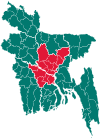|
Nagarkanda Upazila
Nagarkanda (Bengali: নগরকান্দা) is an upazila of Faridpur District in the Division of Dhaka, Bangladesh.[4] In this upazila, in the village of Kodalia, the Pakistani Army killed at least 22 people including women and children on 1 June 1971. The incident is also recorded on film. GeographyNagarkanda is located at 23°24′55″N 89°53′30″E / 23.4153°N 89.8917°E. It has 42,904 households and a total area of 192.20 km2. DemographicsAs of the 2011 Census of Bangladesh, Nagarkanda upazila had 42,904 households and a population of 197,898. 48,422 (24.47%) were under 10 years of age. Nagarkanda had an average literacy rate of 46.79%, compared to the national average of 51.8%, and a sex ratio of 1013 females per 1000 males. 15,805 (7.99%) of the population lived in urban areas.[6][7] According to the 1991 Bangladesh census, Nagarkanda had a population of 267, 193. Males constituted 50.18% of the population, and females 49.82%. The population aged 18 or over was 131, 533. Nagarkanda had an average literacy rate of 22.6% (7+ years), against the national average of 32.4%.[8] Most of the people depends on cultivation of land. Rice, Jute, Onion are the main crops. Onion of this locality is famous all around the country. AdministrationNagarkanda Upazila is divided into Nagarkanda Municipality and nine union parishads: Char Jashordi, Dangi, Fulsuti, Kaichail, Laskardia, Kodalia Shohid Nagar, Purapara, Ramnagar, and Talma. The union parishads are subdivided into 124 mauzas and 169 villages.[6] Nagarkanda Municipality is subdivided into 9 wards and 15 mahallas.[6] Education
See alsoReferences
|
||||||||||||||||||||||||||||||||

